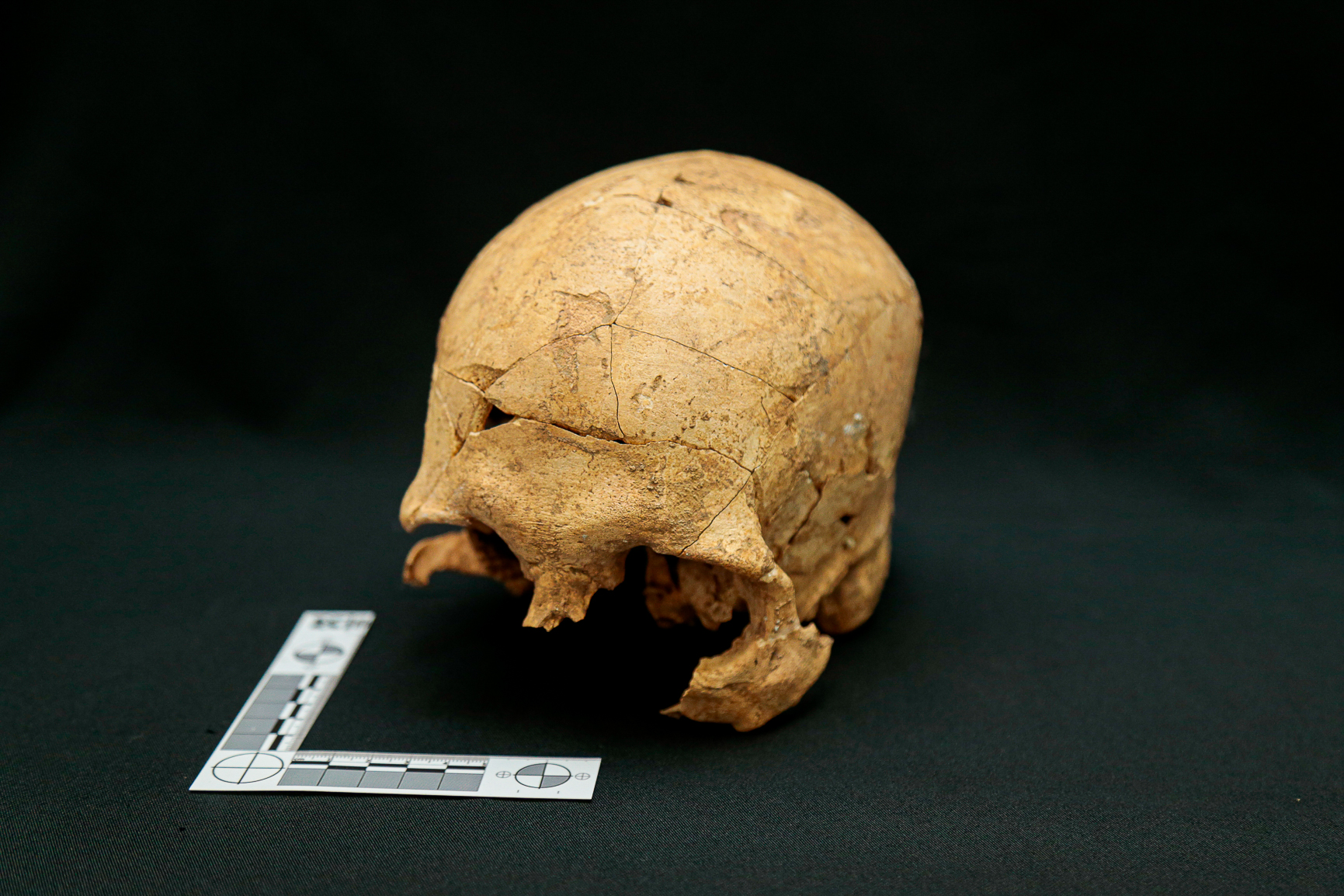Genetic ancestry of the sambaquieiros: what Luzio's DNA reveals
31 Agosto 2023

Luzio’s skull, Museum of Archaeology and Ethnology of USP. Photo: Cecília Bastos/USP Imagens (CC BY-SA 4.0)
The archaeogenetic revolution in Brazil
A study published in Nature Ecology & Evolution (original article) revealed that Luzio—a skeleton about 10,000 years old found in the Ribeira Valley (São Paulo state)—and 34 other individuals from 11 Brazilian archaeological sites are direct ancestors of present-day indigenous peoples. The research, led by scientists from the Museum of Archaeology and Ethnology at USP, marks a milestone for South American archaeogenetics Archaeogenetics: field of science that studies ancient DNA from human and animal populations, allowing the reconstruction of migrations, origins, and evolutionary relationships from archaeological remains..
What are sambaquis and who was Luzio?
Sambaquis Sambaqui: archaeological site formed by large mounds of shells, bones, and artifacts, built by prehistoric peoples of the Brazilian coast between 8,000 and 1,000 years ago. are archaeological mounds mainly made of shells, but also containing human burials, polished stone artifacts, fish and mammal bones, and ritual remains. For about 7,000 years, sambaquieiro groups occupied almost the entire Brazilian coast, building these structures as territorial markers, dwellings, cemeteries, and ceremonial centers. Luzio is the oldest prehistoric inhabitant ever found in São Paulo state, dated to around 8000 BCE. His skeleton was discovered in 1999 at the Capelinha site, located in the municipality of Ribeira, near the border of São Paulo and Paraná. The name “Luzio” was given in reference to Luzia Luzia: name given to the oldest human fossil found in the Americas, dated to about 11,500 years ago, discovered in Lagoa Santa, Minas Gerais, Brazil. The name refers to Lucy, the famous African hominid fossil., the famous female skeleton from Lagoa Santa Lagoa Santa: region in Minas Gerais, Brazil, famous for its archaeological sites, where ancient human fossils—including Luzia—and important remains of the prehistory of the Americas were found., Minas Gerais, considered the oldest human fossil in South America, and named in allusion to Lucy Lucy: one of the oldest and most famous hominid fossils in the world, belonging to the species Australopithecus afarensis, discovered in Ethiopia in 1974 and dated to about 3.2 million years ago., one of the oldest hominid fossils ever discovered.
What did the DNA reveal?
Although Luzio and other sambaquieiros have skulls with shapes different from present-day indigenous peoples, genetic analysis showed they share diversity compatible with today’s native populations. This weakens the hypothesis that the sambaquieiros left no descendants and reinforces the idea of a single major prehistoric migration for the occupation of the eastern coast of South America. The study also brought the first fossil DNA from pre-colonial Amazonian populations, expanding knowledge about the genetic diversity of native peoples.
The sambaquieiros
Although they shared a common origin, sambaquieiro societies in southern and southeastern Brazil had distinct demographic trajectories. In the south, there was intense interaction with inland peoples, speakers of proto-Jê Proto-Jê: name given to the ancestral language of the Jê peoples, indigenous to central and southern Brazil, whose presence dates back thousands of years and influenced several prehistoric cultures in the country. languages, resulting in genetic mixing with ancestors of today’s Caingangue and Xavante. In the southeast, Tupi-Guarani ancestry arrived shortly before European colonization, highlighting the complexity of migrations and cultural contacts. This scenario indicates that sambaquieiro material culture was adopted by genetically related but distinct populations over a vast geographic area and long period, drawing attention to the ethnic and cultural complexity of Brazil’s earliest inhabitants. The disappearance of the sambaquieiros about 2,000 years ago remains a mystery, but data suggest that environmental changes and intensified contact with other groups contributed to the decline of the sambaquis.
Archaeogenetics
Extracting and analyzing ancient DNA in tropical regions is challenging due to degradation by acidic soil and humid climate. Advances in sequencing techniques have allowed recovery of DNA fragments from bones preserved in sambaquis, especially in the humid soils of the Amazon and coast. In 2023, Brazil inaugurated the first archaeogenetics laboratory in South America, at USP, enabling pioneering research and training of new specialists.
Global paleogenomics
The study of the sambaquieiros is part of an international context of advances in paleogenomics, a field highlighted by Svante Pääbo’s Nobel-winning work sequencing the genomes of Neanderthals and Denisovans. Just as Pääbo revolutionized our understanding of human evolution in Eurasia, the Brazilian team helps unravel the genetic history of the Americas, showing that archaeogenetics is essential for reconstructing migratory trajectories, adaptations, and cultural interactions.
Sambaquis: social complexity and legacy
Sambaquis represent one of the most expressive demographic phenomena in South America, with population density and social complexity comparable to the world’s earliest civilizations. The construction of mounds dozens of meters high and hundreds of meters in diameter reveals sophisticated social organization, capable of supporting large populations, developing elaborate rituals, and efficiently exploiting marine resources. Recent studies also show that the sambaquieiros had a diversified diet, rich in fish and seafood proteins, and showed pathologies associated with fishing and aquatic life.
Importance for indigenous history
Ancient DNA research is just one piece of the puzzle of Brazilian prehistory. New studies integrating genetics, archaeology, anthropology, and linguistics promise to reveal even more about the origin, diversity, and adaptations of indigenous peoples. Brazilian pioneering in archaeogenetics paves the way for investigations into megafauna, plant and animal domestication, ancient diseases, and pandemic processes. Recognizing that Luzio and the sambaquieiros are ancestors of present-day indigenous peoples reinforces the importance of valuing and protecting archaeological heritage and the memory of Brazil’s original peoples.
Sources: Scientific article in Nature
Reproduction of material and images is free with citation of sources.